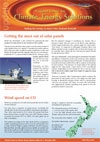Reviving of rainfall stations in Vanuatu

Figure 1: Map of Vanuatu
Jotham Napat, The Director, Vanuatu Meteorological Service
The Schools of the Pacific Rainfall Climate Experiment (SPaRCE) have been working with the Vanuatu Meteorological Services (VMS) since 2005 to strengthen the rainfall recording network in the Republic of Vanuatu.
The Republic of Vanuatu is an archipelago of 83 islands (Figure 1) which spreads from 11°S to 20°S roughly north to south. Transport costs and availability limits the installation and servicing of climate networks here. However, the VMS utilises any available opportunity to install and service climate sites such as VMS staff accompanying other government staff on their visits to the outer islands.
SPaRCE works with local schools and the VMS to expand the climate networks by providing instrumentation and training. The main objective is to involve local schools in installing equipment and recording rainfall information which is then transmitted to the VMS via telephone, email and by other means.
The first phase of funding was used to install rainfall gauges in the various provinces of the Republic of Vanuatu. Firstly, 20 rainfall gauges were installed in the Tafea Province which is made up of 5 islands. On the main island of Tanna, 11 gauges were installed, 3 on Erromango Island, 1 on Aniwa, 2 on Futuna and 3 on Aneityum.
In the Panama Province, 6 sites were installed – 3 on Pentecost and 3 on Ambae. Three further sites were installed on Efate Island in Shefa Province. In Sanma Province, 2 sites were installed on Espiritu Santo Island.
Overall SPaRCE has funded 31 new rainfall sites in the Republic of Vanuatu, with plans to extend the rainfall recording network further. The project is also strengthening telecommunications, which will improve general communications.
Currently, Tafea Province is the only province which has good coverage of rainfall sites. The next phase of funding will aim at strengthening other provinces like Shefa Province which has a large agricultural and tourism base.
The author would like to acknowledge assistance from SPaRCE and also from various government departments in Vanuatu for the success of this project.
